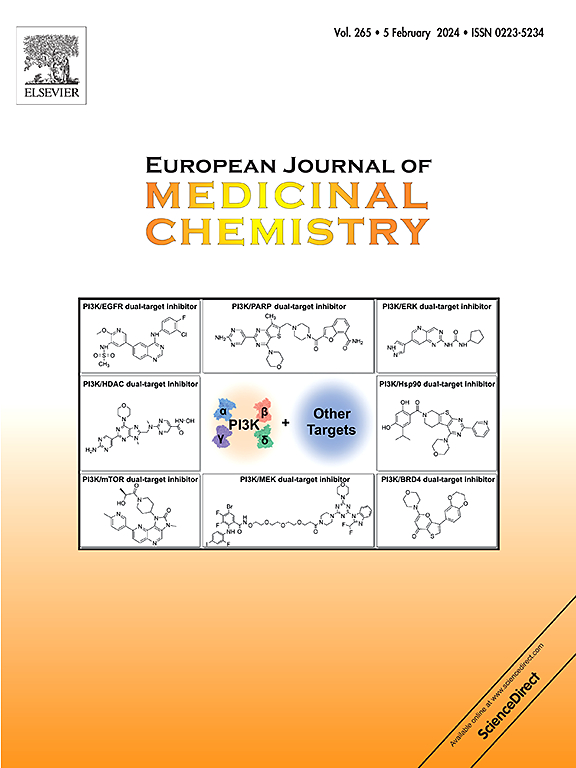hsqc引导下内生真菌青霉菌H-6抗脂肪吲哚二萜的发现和结构优化
IF 6
2区 医学
Q1 CHEMISTRY, MEDICINAL
引用次数: 0
摘要
利用hsqc引导的小分子精确识别技术(SMART)对青霉菌H-6进行化学研究,分离出9个新的吲哚二萜(IDTs), penijanidines D−L(1−9),以及4个已知的类似物(10−13)。从结构上看,化合物1代表了一种不常见的含亚胺的IDT,而化合物2和3是罕见的1(2),2(18)-二-二-IDT衍生物。通过光谱分析和计算方法确定了它们的绝对构型和结构。同时,对原代penijbirine(15)进行结构优化,得到22个新的IDTs衍生物(21−42)。系统评估了42种IDTs的抗脂肪作用,包括13种分离的(1 ~ 13),7种先前报道的(14 ~ 20)和22种半合成衍生物(21 ~ 42),在3T3-L1脂肪细胞中发现结构优化的衍生物38是最有效的降低甘油三酯活性的分子,其EC50值为0.25±0.05 μM。初步的构效关系(SAR)分析强调了这些化合物降脂功效的关键药效特征。机制研究表明,38通过激活AMPK信号通路抑制脂肪生成和脂肪生成,AMPK磷酸化(p-AMPK)显著增加。表面等离子体共振(SPR)进一步证实化合物38与AMPK蛋白直接结合,亲和度KD =12.4 μM。本研究不仅扩大了生物活性idt的化学多样性,而且确定了38作为一种新的靶向ampk的先导化合物,具有潜在的抗肥胖药物开发潜力。本文章由计算机程序翻译,如有差异,请以英文原文为准。


HSQC-guided discovery and structural optimization of antiadipogenic indole diterpenoids from endophytic fungus Penicillium janthinellum H-6
Chemical investigation of Penicillium janthinellum H-6 using HSQC-guided small molecule accurate recognition technology (SMART) led to the isolation of nine new indole diterpenoids (IDTs), penijanidines D−L (1−9), along with four known analogues (10−13). Architecturally, compound 1 represents an unusual imine-containing IDT, while compounds 2 and 3 are rare 1(2),2(18)-di-seco-IDT derivatives. Their structures including absolute configuration were determined by spectroscopic analysis and computational method. Meanwhile, structure optimization of the primary penijbirine (15) was conducted to obtain 22 new IDT derivatives (21−42). Systematic evaluation of the antiadipogenic effects of 42 IDTs, including 13 isolated ones (1−13), seven previously reported ones (14−20), and 22 semi-synthetic derivatives (21−42), in 3T3-L1 adipocytes identified the structurally optimized derivative 38 as the most potent molecular for triglyceride-lowering activity, exhibiting an EC50 value of 0.25 ± 0.05 μM. Preliminary structure-activity relationship (SAR) analysis highlighted critical pharmacophoric features governing the lipid-lowering efficacy of these compounds. Mechanism studies revealed that 38 suppressed adipogenesis and lipogenesis via activating the AMPK signaling pathway, evidenced by significantly increased phosphorylation of AMPK (p-AMPK). Surface plasmon resonance (SPR) assays further confirmed that compound 38 directly bond to the AMPK protein with an affinity of KD = 12.4 μM. This study not only expands the chemical diversity of bioactive IDTs but also identifies 38 as a novel AMPK-targeting lead compound for potential anti-obesity drug development.
求助全文
通过发布文献求助,成功后即可免费获取论文全文。
去求助
来源期刊
CiteScore
11.70
自引率
9.00%
发文量
863
审稿时长
29 days
期刊介绍:
The European Journal of Medicinal Chemistry is a global journal that publishes studies on all aspects of medicinal chemistry. It provides a medium for publication of original papers and also welcomes critical review papers.
A typical paper would report on the organic synthesis, characterization and pharmacological evaluation of compounds. Other topics of interest are drug design, QSAR, molecular modeling, drug-receptor interactions, molecular aspects of drug metabolism, prodrug synthesis and drug targeting. The journal expects manuscripts to present the rational for a study, provide insight into the design of compounds or understanding of mechanism, or clarify the targets.

 求助内容:
求助内容: 应助结果提醒方式:
应助结果提醒方式:


